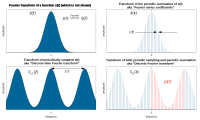
Photo from wikipedia
In this brief, an effective method is introduced to obtain the steady-state response of non-linear circuits. It involves the application of the discrete singular convolution method in the time domain.… Click to show full abstract
In this brief, an effective method is introduced to obtain the steady-state response of non-linear circuits. It involves the application of the discrete singular convolution method in the time domain. A cyclic form involving Shannon’s series kernel is used to express the derivatives in the ordinary differential equations representing the circuit’s mathematical model. This leads to a simple matrix expression for the derivatives. The matrix coefficients are independent of the number of unknown signals in the circuit and depend only on the number of sample points chosen in the steady-state analysis. The procedure transforms differential equations into a system of non-linear algebraic equations, that can be solved using the Newton–Raphson method. Several examples illustrate the performance of the developed method.
Journal Title: IEEE Transactions on Circuits and Systems II: Express Briefs
Year Published: 2019
Link to full text (if available)
Share on Social Media: Sign Up to like & get
recommendations!